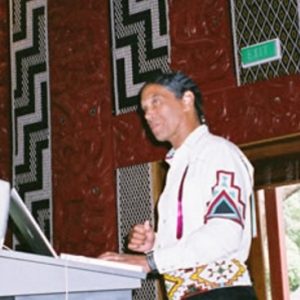In today’s interview with a language expert, we had the exciting opportunity to hear from Dr. Neyooxet Greymorning.
 Dr. Greymorning, a political anthropologist, holds joint positions in Anthropology and Native American Studies at the University of Montana. His research among Indigenous peoples has spanned Australia, Canada, Colombia S.A., New Zealand, E. Timor and the United States. As the Executive Director of Hinono’eitiit Ho’oowu’ (Arapaho Language Lodge) in Wyoming, he has also developed a method for second language instruction and acquisition called Accelerated Second Language Acquisition.
Dr. Greymorning, a political anthropologist, holds joint positions in Anthropology and Native American Studies at the University of Montana. His research among Indigenous peoples has spanned Australia, Canada, Colombia S.A., New Zealand, E. Timor and the United States. As the Executive Director of Hinono’eitiit Ho’oowu’ (Arapaho Language Lodge) in Wyoming, he has also developed a method for second language instruction and acquisition called Accelerated Second Language Acquisition.
Here he speaks with NML Vice President Greg Nedved about the current state of Native American languages.
What is the biggest misperception about Native American languages in general?
Most people are unaware of the crisis situation that exists for Native languages. Many aren’t even aware that there are any Indian tribes that are still around.
What do you think about the state of Native American languages in the United States?
Of the once 500+ Native languages spoken the number has been reduced to less than 140. With a speaking population of perhaps 100,000 the only Native Navajo language is perhaps the only language on the mainland that is doing well, the others are all in jeopardy of being lost.
How does the United States compare with Canada, Australia and New Zealand, in its advocacy of indigenous languages?
Given the present attitude and resources these other countries have earmarked for Indigenous language revitalization efforts, I would say that the U.S. is way behind these other countries.
How can language museums most effectively promote endangered language maintenance and restoration?
The National Museum of the American Indian does an okay job, even if language is not really a part of its mission. Language maintenance and restoration is not really what Museums promote. Advocating for Native language maintenance and restoration requires an entire shift in the U.S. ethnocentric fabric of English only. The struggle is one that finds itself in conflict and competition with other ethnic languages in the U.S.
How did you come up with your Accelerated Second Language Acquisition tool concept?
Out of necessity, the mother of invention.
Can language flags and other symbols play a role in the protection and advocacy of indigenous languages?
Not really. Tribal flags and insignia have been around for more than half a century. Has it made any difference in your worldview or perspective of the situation? You would need a situation similar to the story of Sylvan Hart where the court stated he was as much a part of the National forest he retreated to as the forest itself, and thus ruled that he could continue to live there.
Native/Indigenous languages would have to become a symbol of America, like the Eagle. Then they would have to be protected from extinction.
